Aérospatiale Alouette III
| SA 316/SA 319 Alouette III | |
|---|---|
.jpg) | |
| A Netherlands Air Force Alouette III during '100th Anniversary of Dutch Military Aviation' airshow | |
| Role | Light utility helicopter |
| National origin | France |
| Manufacturer | Sud Aviation Aérospatiale |
| First flight | 28 February 1959 |
| Introduction | 1960 |
| Status | In service |
| Primary users | French Armed Forces Rhodesian Air Force Indian Armed Forces[N 1] Portuguese Air Force[1] South African Air Force[1] (historical) |
| Produced | 1961–1985 (HAL Chetak still in production) |
| Number built | 2,000+ |
| Developed from | Aérospatiale Alouette II |
| Variants | IAR 316 |
| Developed into | Aérospatiale Gazelle Atlas XH-1 Alpha |
The Aérospatiale Alouette III (French pronunciation: [alwɛt], Lark; company designations SA 316 and SA 319) is a single-engine, light utility helicopter developed by French aircraft company Sud Aviation. During its production life, it proved to be a relatively popular rotorcraft; including multiple licensed manufacturers, in excess of 2,000 units were constructed.
The Alouette III was developed as an enlarged derivative of the earlier and highly successful Alouette II. Sharing many elements with its predecessor while offering an extra pair of seats and other refinements, it quickly became a commercial success amongst both civil and military customers. Further variants were also developed; amongst these was a high-altitude derivative, designated as the SA 315B Lama, entered operational service during July 1971. The Alouette III was principally manufactured by Aérospatiale; the type was also built under licence by Hindustan Aeronautics Limited (HAL) in India as the HAL Chetak, by Industria Aeronautică Română (IAR) in Romania as the IAR 316 and F+W Emmen (de) in Switzerland.
Similar to the Alouette II, in military service, it was used to perform missions such as aerial observation, photography, air-sea rescue, liaison, transport and training; it could also be armed with anti-tank missiles, anti-shipping torpedoes, and a fixed cannon. In a civilian capacity, the Alouette III was commonly used for casualty evacuation (often fitted with a pair of external stretcher panniers), crop-spraying, personnel transportation, and for carrying external loads. By the 2010s, many operators were in the process of drawing down their fleets and replacing them with more modern types; the French military intend to replace their Alouette IIIs with the newly-developed Airbus Helicopters H160.[2]
Development
Origins
The Alouette III has its origins with an earlier helicopter design by French aircraft manufacturer Sud-Est, the SE 3120 Alouette, which, while breaking several helicopter speed and distance records in July 1953, was deemed to have been too complex to be realistic commercial product.[3][4] Having received financial backing from the French government, which had taken an official interest in the venture, the earlier design was used as a starting point for a new rotorcraft that would harness the newly developed turboshaft engine; only a few years prior, Joseph Szydlowski, the founder of Turbomeca, had successfully managed to develop the Artouste, a 260 hp (190 kW) single shaft turbine engine derived from his Orédon turbine engine. This engine was combined with the revised design to quickly produce a new helicopter, initially known as the SE 3130 Alouette II.[3][5][6]
During April 1956, the first production Alouette II was completed, becoming the first production turbine-powered helicopter in the world.[3] The innovative light helicopter, soon broke several world records and became a commercial success.[7][8] As a result of the huge demand for the Alouette II, manufacturer Aérospatiale took a great interest in the development of derivatives, as well as the more general ambition of embarking on further advancement in the field of rotorcraft.[9]
In accordance with these goals, the company decided to commit itself to a new development programme with the aim of developing a more powerful helicopter that would be capable of accommodating up to 7 seats or a pair of stretchers. The design team was managed by French aerospace engineer René Mouille.[9][10][11] The design produced, which was initially designated as the SE 3160, featured several improvements over the Alouette II; efforts were made to provide for a higher level of external visibility for the pilot as well as for greater aerodynamic efficiency via the adoption of a highly streamlined exterior.[9]
Into flight

On 28 February 1959, the first prototype SE 3160 performed its maiden flight, piloted by French aviator Jean Boulet.[9][10] Shortly thereafter, the SE 3160 would become more commonly known as the Alouette III. During its flight test programme, the prototype demonstrated its high altitude capabilities on several occasions; in June 1959, it landed at an altitude of over 4,000 meters in the Mont Blanc mountain range and, during October 1960, it was able to achieve the same feat at an altitude in excess of 6,000 meters in the Himalayas. During these attempts, it was flown by Jean Boulet, who was accompanied by a pair of passengers and 250 kg of equipment.[9]
During 1961, the initial model of the type, designated as the SA 316A (SE 3160), entered serial production.[9] On 15 December 1961, the Alouette III received its airworthiness certificate, clearing it to enter operational service. Despite an order placed by the French Army for an initial batch of 50 Alouette IIIs during June 1961, the first two customers of the rotorcraft were in fact export sales, having been sold outside of France.[9] The Alouette III was specifically designed to fly at high altitudes, as such, it quickly earned a reputation for its favourable characteristics during rescue operations. According to its manufacturer, it was the first helicopter to present an effective multi-mission capability and performance to match with its diverse mission range in both civil or military circles.[9]
The SA 316A model continued to be produced until 1968, when it was replaced by the refined SA 316B model.[9] A key feature of the rotorcraft is its gas turbine engine; while the original variant had been powered by the same Artouste engine of the Alouette II, it was substantially more powerful, being originally rated to produce 880 horsepower, but intentionally de-rated to generate 550 horsepower in service. The more powerful Turbomeca Astazou engine would be adopted on the later models; on 10 July 1967, the first Alouette III to be powered by the Astazou engine performed its first flight.[9] During 1979, the last and 1,437th Alouette III departed from the company's assembly line in Marignane, France, after which the main production line was closed down as a consequence of diminishing demand for the type. During 1985, the final Alouette III was delivered.[9]
Overseas production
Despite the closure of Aérospatiale 's own production line, the event was not the end of the type's manufacturing activity. Over 500 Alouette IIIs are recorded as having been manufactured under licence abroad in several countries, such as Romania, India, and Switzerland.[9] Hindustan Aeronautics Limited (HAL) obtained a licence to construct the Alouette III, which was known locally as the HAL Chetak, at their own production facilities in India.[9] In excess of 300 units were built by HAL; the company has continued to independently update and indigence the helicopter over the decades. A modernised variant of the Chetak has remained production, though at a diminished volume, into the 21st century. Various versions of the Alouette III were also either licence-built or otherwise assembled by IAR in Romania (as the IAR 316), F+W Emmen (de) in Switzerland, and by Fokker and Lichtwerk in the Netherlands.[9][12]
By the 2010s, the majority of Alouette III operators were in the process of winding down or entirely retiring their fleets.[2] During 2017, the French Navy observed that it was costing the service around 13,000 Euros per flight hour to operate a single Alouette III, which it claims was in excess of double the equivalent costs of a modern-day rotorcraft in its class; it attributed this high running cost as being a natural side effect of their fleet's advanced age and an overall shortage of spare parts for the type, which has in turn been caused by the mass production of the Alouette III having been terminated three decades earlier. Furthermore, retirement has also been motived by a lack of modern features that would be present upon contemporary helicopters, which is a natural consequence of the Alouette III having been originally developed during the 1950s.[2]
Operational history

Argentina
The Argentine Naval Aviation operated a total of 14 Alouette III helicopters. A single SA316B was on board the ARA General Belgrano when she was sunk by torpedoes fired by HMS Conqueror during the 1982 Falklands War between Argentina and the United Kingdom. A second Alouette III played an important role during the Argentine Invasion of South Georgia. On 2 December 2010, the last example was retired at a ceremony held at BAN Comandante Espora, Bahía Blanca.[13][14]
Australia
Between April 1964 and 1967, a small batch of Alouette IIIs were delivered from France in a disassembled state to Australia. Following their assembly, these were used by the Royal Australian Air Force (RAAF) at the Woomera Rocket Range for light passenger transport purpose and to assist in the recovery of missile parts in the aftermath of test launches conducted at the Range.[15]
Chile
During 1977, the Chilean Navy ordered a batch of ten SA-319Bs. These rotorcraft, which were delivered by the middle of 1978, were only made operational just before the peak of the Beagle conflict between Chile and neighbouring Argentina. The Alouette III was the first real organic maritime ship borne tactical helicopter to be operated by Chile's naval forces; for this role, they were equipped with a radar and armed with rockets, guns, depth charges and a single light anti-submarine torpedo.
During the frantic training period in 1978 to meet wartime needs, a sole SA-319B was accidentally damaged, leading to it being placed in storage and subsequently repaired back to an airworthy condition years later. All ten Chilean Navy SA-319Bs were operational and in excellent conditions by the end of the 1980s, shortly after which they were replaced by larger SA532 Super Puma helicopters, and were bought by civilian operators.
Denmark
Between 1962 and 1967, a total of 8 Alouette IIIs were delivered to the Royal Danish Navy. They were primarily tasked with SAR and reconnaissance in support of the navy's Arctic patrol ships. During 1982, they were replaced by a batch of British Westland Lynx.[16]
France
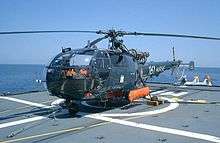
During early 1960, the Alouette III officially entered squadron service with the French armed forces. In June 1971, having been suitably impressed by the type's performance so far, the French Army elected to order a force of 50 Alouette IIIs for their own purposes. Amongst the most noteworthy uses that France applied the type to was the first use of helicopter-based anti-tank missiles in the form of the SS.11 MCLOS wire-guided missile.[17]
During June 1960, an Alouette III carrying seven people successfully performed both take-offs and landings on Mont Blanc in the French Alps at an altitude of 4,810 meters (15,780 feet), an unprecedented altitude for such activities by a helicopter at the time.[18] The same helicopter again demonstrated the type's extraordinary performance in November 1960 by making take-offs and landings with a crew of two and a payload of 250 kg (551 lbs) in the Himalayas at an altitude of 6,004 meters (19,698 feet).[18]
During June 2004, the Alouette III was retired from the French Air Force after 32 years of successful service, having been entirely replaced by the newer twin-engined Eurocopter EC 355 Ecureuil 2. The French Army also withdrew the last of their examples during 2013 in favour of more modern rotorcraft.[2]
By 2017, the French Navy were still using the Alouette III in a reduced capacity, nonetheless being used to routinely conduct both Search and Rescue and logistics missions.[19] Since the 1970s, the type has gradually been supplanted by the larger Eurocopter AS365 Dauphin, and later on, by the specialised Eurocopter AS565 Panther as an anti-submarine warfare platform. The use of twin-engined rotorcraft in the maritime environment has become somewhat of an expected standard, one which the single-engined Alouette III cannot satisfy, putting the type at an obvious disadvantage.[2] During January 2018, it was announced that the French Navy would be replacing its remaining Alouette IIIs with rented Aérospatiale SA 330 Pumas as a stop-gap measure; this decision was reportedly taken due to its increasing unreliability, rapidly inflating operating costs, and the sheer age of the fleet.[2][20]
Ireland
.jpg)
During 1963, the first pair of Alouette IIIs were delivered to the Irish Air Corps; a third rotocraft arrived in 1964 and a batch of five further aircraft were delivered between 1972 and 1974. The service ultimately operated a total of eight Alouette IIIs between 1963 and 2007; throughout much of this period, they were the only helicopters operated by the Corps.
On 21 September 2007, the Alouette III was formally retired from the Irish Air Corps during a ceremony held at Baldonnel Aerodrome. During 44 years of successful service, the Irish Alouette III fleet amassed over 77,000 flying hours. As well as routine military missions, the aircraft undertook some 1,717 search-and-rescue missions, saving 542 lives and flew a further 2,882 air ambulance flights. The oldest of the Alouettes, 195, is kept in 'rotors running' condition for the Air Corps Museum.[21]
India
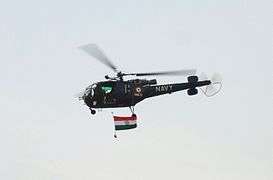
Under a licensing arrangement between Aérospatiale and Indian aircraft manfucturer Hindustan Aeronautics Limited (HAL), the Alouette III has been built under licence by HAL in India. Known locally under the designation HAL Chetak, in excess of 300 rotorcraft have been manufactured to date; the majority of these were acquired for military purposes with the Indian Armed Forces, who have used them to perform various mission roles, including training, transport, CASEVAC (casualty evacuation), communications and liaison roles.[22] By 2017, the Chetak was reportedly serving as the most widely used IAF helicopter for training, light utility and light attack roles.[23]
During 1986, the Indian Government constituted the Army's Aviation Corps; consequently, the majority of Chetaks previously operated by AOP Squadrons were transferred from the Indian Air Force to the Indian Army on 1 November 1986. The Air Force has continued to fly a force of armed Chetaks in the anti-tank role as well as for CASEVAC missions and general duties. During the 2010s, the Chetak is being gradually replaced by the newer HAL Dhruv in the armed forces.[22] An option to re-engine the HAL Chetak with the Turbomeca TM 333-2B engine, which would better facilitate high-altitude operations in the Himalayas was considered, but ultimately not pursued.
In addition to producing the type for Indian customers, HAL has also achieved some export sales of Chetak helicopters to several nations, including Namibia and Suriname.[24][25] India has also opted to donate several secondhand Chetak helicopters to other countries, such as neighbouring Nepal.[26] As of 2017, the Indian Navy has been reportedly recognised the necessity of procuring a replacement for the type.[27]
Pakistan
During the 1960s, Pakistan purchased a fleet of 35 Alouette III helicopters to equip the Pakistan Air Force (PAF). These saw active combat during the Indo-Pakistani War of 1971, in which the type was mainly used for liaison and VIP-transport missions. A pair of PAF Alouette IIIs were recorded as having been shot down during the conflict.[28] In 2010, it was announced that Switzerland had come to an agreement with Pakistan for a number of ex-Swiss Alouette IIIs to be donated to the PAF; however, the terms of this agreement restricts their usage to performing search and rescue and disaster relief operations.[29]
Portugal
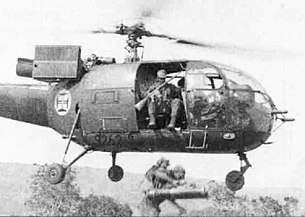
Portugal was the first country to use the Alouette III in combat. In 1963, during the Overseas Wars in Angola, Mozambique and Portuguese Guinea, Portugal began using Alouette IIIs in combat, mainly in air assault and medevac operations, where it proved its qualities. Besides the basic transport version (code named canibal, plural canibais), Portugal used a special version of the Alouette III with a MG 151 20 mm autocannon mounted in the rear in order to fire from the left side door; it was designated helicanhão (heli-cannon) and code named lobo mau (big bad wolf).
In the Overseas Wars, the Portuguese usually launched air assaults with groups of six or seven Alouette III: five or six canibais – each usually carrying five paratropers or commandos – and a lobo mau heli-cannon. The Portuguese practice was for the troops to jump from the canibais when the helicopters were hovering two-three meters above the ground – famous images of these disembarking troops became an iconic image of the war. The landing of the troops was covered by the lobo mau. While the troops performed the ground assault, the canibais moved away from the combat zone, while the lobo mau stayed to provide fire support, destroying enemy resistance and concentration points with the fire from its 20 mm autocannon. Once the ground combat had finished, the canibais returned; firstly to collect the wounded, then the rest of the troops.
At present, the Portuguese Air Force maintains a number of Alouette IIIs in service, mainly for training and SAR. They also equip the aerobatic team Rotores de Portugal.
Rhodesia
The nation of Rhodesia emerged as a prolific user of both the Alouette II and its enlarged sibling, the Alouette III.[30] Early operations were flown with an emphasis on its use by the Rhodesian Army and British South Africa Police, including paramilitary and aerial reconnaissance operations. Throughout the 1960s, the type progressively spread into additional roles, including aerial supply, casualty evacuation, communications relays, and troop-transports.[31] Rhodesian aerial operations would typically involve flying under relatively high and hot conditions, which reduced the efficiency of aircraft in general; however, the Alouette II proved to be both hardy and relatively resistant to battle damage.[32] In order to extend the inadequate range of the type, fuel caches were strategically deployed across the country to be used for refuelling purposes.[31]
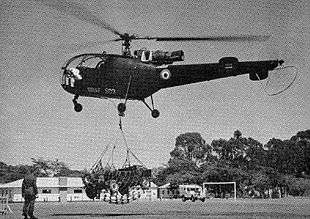
At its peak, No. 7 Squadron of the Rhodesian Air Force operated a force of 34 Allouette IIIs, which would normally operate in conjunction with a smaller number of Allouette IIs. They played a major part in the Rhodesian Forces' Fireforce doctrine, in which they would rapidly deploy ground troops, function as aerial observation and command posts, and provide mobile fire support as armed gunships.[33] In order to improve performance, Rhodesia's Alouette fleet was subject to extensive modifications during its service life, including changes to their refueling apparatus, gun sights, and cabin fittings, along with the installation of additional armouring and armaments.[34]
Over time, the Rhodesian Security Forces developed an innovative deployment tactic of rapidly encircling and enveloping enemies, known as the Fireforce, for which the Alouette II served as a core component.[30] The quick-reaction Fireforce battalions were typically centered at Centenary and Mount Darwin; however, an deliberate emphasis was placed on locating both rotorcraft and troops as close to a current or anticipated theatre of operations as would be feasibly possible.[35]
South Africa

The Alouette III served for over 44 years in the South African Air Force (SAAF); it is believed that 121 examples were acquired between 1962 and 1975 for the service from France.[36] During 1966, by which point the SAAF had built up a fleet of around 50 Alouette IIIs already, it was decided to dispatch several of the type to support ground troops stationed in South West Africa attempting to contain the emerging South West African People's Organisation (SWAPO); this would be the beginnings of what would become the lengthy South African Border War.[36] The type saw considerable action during the conflict; while initially used for more passive operations such as aerial reconnaissance, from July 1967 onwards, Alouette III participated in active combat missions as well. It was frequently employed as a support platform for performing South African counterstrike operations inside neighbouring Namibia and Angola.[37] Reportedly, a total of eight Alouette IIIs had been listed as having been lost over the conflict zone by the end of the war.[36]
By 1990, there were a total of 70 Alouette III helicopters remaining in active service.[36] Throughout the course of its service life with the SAAF, the Alouette III fleet was recorded as having accumulated in excess of 346,000 flight hours. During June 2006, the last Alouette III was officially withdrawn from SAAF service at a ceremony held at AFB Swartkop, near Pretoria.[37]
During January 2013, reports emerged that South African defense officials were in the process of planning to transfer some of the retired fleet, along with spare parts and associated support equipment, to the Zimbabwean Air Force; South African newspaper Mail & Guardian claimed that the rotorcraft could be used to sway politics in the nation in favour of the incumbent President, Robert Mugabe.[38] However, during February 2013, an interim court order was issued which blocked the proposed sale of South African Alouette IIIs to Zimbabwe.[39] In February 2014, reports emerged that South Africa now intended to sell part of the ex-SAAF fleet to Namibia instead.[40]
Suriname
During 1986, the South American country of Suriname purchased a pair of secondhand Alouette III helicopters from Portugal. During 1999, the Surinam Air Force opted to retire and sell off its Alouette III helicopters. In their place, three newly-built HAL Chetaks (an Indian version of the Alouette IIIs) were delivered to the Suriname Air Force on 13 March 2015, while the pilots and technicians of the Surinam Air Force underwent training on the type in Bangalore, India for some time.[41][42][43]
Switzerland
_(4831664942).jpg)
During 1964, the Swiss Air Force opted to procure a batch of nine Alouette III rotorcraft directly from Aérospatiale; further orders included one placed in 1966 for 15 more. In addition, a total of 60 SA-316Bs (often referred to as the F+W Alouette IIIS) were licence-assembled by F+W Emmen in Switzerland.
During 2004, the Swiss Armed Forces announced the expected withdrawal of the Alouette III from front-line service would commence by 2006 and that it was to be entirely retired by 2010; they have been replaced by a smaller force of 20 new-built Eurocopter EC635s. Since their retirement, at least 10 ex-Swiss Alouettes have been gifted to Pakistan to perform search and rescue operations.[29]
Variants
- SA 316A : the first production version. Original designation SE 3160.[44]
- SA 316B : powered by a 425 kW (570 shp) Turboméca Artouste IIIB turboshaft engine, with strengthened main and tail rotor for greater performance. The SA 316B was built under licence in India as the HAL Chetak, and again under licence in Romania as the IAR 316.[45]
- The SA 319B was a direct development of the SA 316B, it was powered with a 649 kW (870 shp) Turbomeca Astazou XIV turbo shaft engine, but it was derated to 447 kW (660 hp).[45]
- The SA 316C was powered by a Turbomeca Artouste IIID turboshaft engine. The SA 316C was only built in small numbers.[45]
- G-Car and K-Car : Helicopter gunship versions for the Rhodesian Air Force.[47] The G-Car was armed with two side-mounted Browning .303 or a single 7.62mm MAG machine guns. The K-Car was armed with a 20 mm MG 151 cannon, fitted inside the cabin, firing from the port side of the helicopter.
- SA.3164 Alouette-Canon: Modified in 1964 as a gunship version armed with a 20mm gun in the nose and external hardpoints for missiles mounted on each side of the fuselage. Only one prototype was built.[48]
- IAR 317 Airfox: A Romanian helicopter gunship project based on the IAR 316. Only three prototypes were ever built.[46]
- Atlas XH-1 Alpha: South African two-seat attack helicopter project. It was used in the development of the Denel Rooivalk.[49][45]
Operators
Current military operators

.jpg)

Former military operators
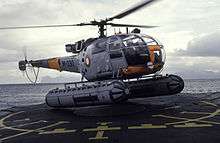
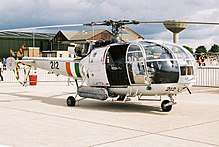
.jpg)
Specifications (SA 316B)
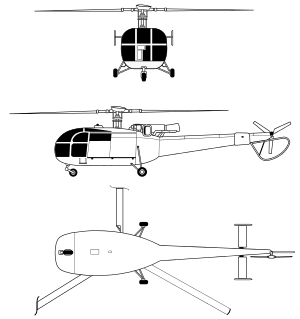
Data from Jane's All The World's Aircraft 1976–77,[96] A Compendium of Armaments and Military Hardware[97]
General characteristics
- Crew: 2
- Capacity: 5 passengers
- Length: 10.03 m (32 ft 10¾ in)
- Main rotor diameter: 11.02 m (36 ft 1¾ in)
- Height: 3.00 m (9 ft 10 in)
- Main rotor area: 95.38 m2 (1026 ft2)
- Empty weight: 1,143 kg (2,520 lb)
- Gross weight: 2,200 kg (4,850 lb)
- Powerplant: 1 × Turbomeca Artouste IIIB turboshaft, 649 kW (870 shp) derated to 425 kW (570 hp)
Performance
- Maximum speed: 210 km/h (130[98] mph)
- Cruising speed: 185 km/h (115 mph)
- Range: 540 km (335 miles)
- Service ceiling: 3,200 m (10,500 ft)
- Rate of climb: 4.3 m/s (850 ft/min)
See also
Related development
Aircraft of comparable role, configuration and era
Related lists
References
Notes
Citations
- 1 2 3 "SIPRI arms transfer database". Stockholm International Peace Research Institute. 19 March 2012. Retrieved 21 November 2013.
- 1 2 3 "1955: SE3130 "Alouette II"." Archived 22 December 2015 at the Wayback Machine. Eurocopter, Retrieved: 20 December 2015.
- ↑ Boyne 2011, p. 101.
- ↑ Boyne 2011, p. 271.
- ↑ McGownen 2005, p. 226.
- ↑ "FAI Record ID #9874 – Altitude without payload. Class E-1 (Helicopters), turbine Archived 17 December 2014 at the Wayback Machine." Fédération Aéronautique Internationale (FAI). Retrieved: 21 September 2014.
- ↑ Taylor 1966, p. 2.
- 1 2 3 4 5 6 7 8 9 10 11 12 13 14 "1959: SA3160/ SA316/ SA319 B "Alouette III"." Airbus Helicopters, Retrieved: 18 February 2018.
- 1 2 McGownen 2005, p. 75.
- ↑ Polmar and Kennedy 1981, p. 32.
- ↑ McGownen 2005, p. 227.
- ↑ Adiós Alouette Archived 8 December 2010 at the Wayback Machine.
- ↑ "Argentine Navy's Final Alouette III Retired". Air Forces Monthly. Key Publishing Ltd (275): 24. March 2011. ISSN 0955-7091.
- ↑ "Father Christmas always arrives in a helicopter." listeningtothepast.com.au, 2 December 2017.
- ↑ Schrøder, Hans (1991). "Royal Danish Airforce". Ed. Kay S. Nielsen. Tøjhusmuseet, 1991, p. 1–64. ISBN 87-89022-24-6.
- ↑ Boyne 2011, p. 74.
- 1 2 Donald 1997, p. 22.
- ↑ Laurent Lagneau (5 December 2017). "La Marine nationale envisage de louer des hélicoptères civils d'occasion pour remplacer ses Alouette III" (in French). Zone militaire.
- ↑ Cabirol, Michel. "En attendant le H160, l'armée va louer des Dauphin pour remplacer ses antiques Alouette." La Tribune, 19 January 2018.
- ↑ "New Wings for the Irish Air Corps". airsceneuk.org.uk. Retrieved 3 July 2015.
- 1 2 Rahul Singh (5 January 2017). "Cheetah, Chetak choppers to retire after string of crashes raise safety concerns". Hindustan Times. Retrieved 23 January 2018.
- ↑ "The Chetak’s Hyderabad connect." Deccan Chronicle, 20 December 2017.
- ↑ "HAL delivers Namibian helicopters". defenceWeb. 15 February 2011. Retrieved 23 January 2018.
- ↑ Dylan Malyasov (16 March 2015). "Suriname Air Force gets 3 Chetak helicopters from India". Defense Blog. Retrieved 23 January 2018.
- ↑ Upreti 2008, p. 119.
- ↑ Raghuvanshi, Vivek. "Indian Navy floats $10B helicopter acquisition program." defensenews.com, 23 August 2017.
- ↑ "Archived copy". Archived from the original on 3 May 2006. Retrieved 28 May 2006.
- 1 2 "Switzerland Gives Its Alouette III Helicopters to Pakistan to Reinforce Search and Rescue Assets." defense-aerospace.com, 8 September 2010.
- 1 2 Cocks 2015, p. 18.
- 1 2 Cocks 2015, p. 20.
- ↑ Cocks 2015, p. 19.
- ↑ "Rhodesian Air Force – No 7 Squadron". Rhodesian Army Association. Retrieved 14 December 2013.
- ↑ Cocks 2015, pp. 20–22.
- ↑ Cocks 2015, pp. 21–22.
- 1 2 3 4 Wessels, André. "The South African Air Force, 1920–2012: A Review of its History and an Indication of its Cultural Heritage." Scientia Militaria, vol 40, no 3, 2012, pp.222-249.
- 1 2 Dean Wingrin. "The South African Air Force". saairforce.co.za. Retrieved 3 July 2015.
- ↑ Brümmer, Stefaans and Craig McKune. "South Africa's helicopter gift for Mugabe." Mail & Guardian, 25 January 2013.
- ↑ SABC: Zim helicopter interdict confirmed. sabc.co.za, 2 February 2013.
- ↑ "South African Alouette IIIs apparently destined for Namibia, not Zimbabwe." defenceweb.co.za, 18 February 2014.
- ↑ "2014 August 17 – Times of Suriname – grootste landelijke dagblad van Suriname". Times of Suriname – grootste landelijke dagblad van Suriname. Retrieved 3 July 2015.
- ↑ "Starnieuws – Eerste Chetak helikopter in elkaar gezet op basis Luchtmacht". starnieuws.com. Retrieved 3 July 2015.
- ↑ "Starnieuws – Luchtmacht neemt Chetak-helikopters in gebruik". starnieuws.com. Retrieved 3 July 2015.
- ↑ Chant 2014, pp. 348-349.
- 1 2 3 4 5 Chant 2014, p. 349.
- 1 2 Chant 2014, pp. 349-415.
- ↑ Wood, J.R.T (2009). Counter-strike From the Sky: The Rhodesian All-arms Fireforce in the War in the Bush 1974–1980. 30° South Publishers. ISBN 1-920143-33-5.
- ↑ "SA 3164 "Alouette Canon" – Stingray's List of Rotorcraft". google.com. Retrieved 3 July 2015.
- ↑ McGownen 2005, p. 204.
- 1 2 3 4 5 6 7 8 9 10 11 12 13 14 15 16 17 18 19 20 21 22 23 24 25 "World Air Forces 2018". Flightglobal Insight. 2018. Retrieved 4 August 2018.
- ↑ Martin, Guy. "Mauritius commissions patrol vessel, receives two helicopters - defenceWeb". www.defenceweb.co.za.
- ↑ "World Air Forces 1975". flightglobal.com. p. 291. Retrieved 23 March 2013.
- ↑ "Comando de Aviacion Naval Argentina Alouette III". Retrieved 30 March 2013.
- ↑ Jowett, Philip (2016). Modern African Wars (5): The Nigerian-Biafran War 1967-70. Oxford: Osprey Publishing Press. p. 18. ISBN 978-1472816092.
- ↑ "World Air Forces 1983". flightglobal.com. p. 327. Retrieved 30 March 2013.
- ↑ "World Air Forces 1987". flightglobal.com. p. 44. Retrieved 30 March 2013.
- ↑ "World Air Forces 1975". flightglobal.com. p. 293. Retrieved 30 March 2013.
- ↑ "Armada de Chile Alouette III". Retrieved 30 March 2013.
- ↑ "Kongelige Danske Marine Alouette III". Retrieved 30 March 2013.
- ↑ "World Air Forces 1987". flightglobal.com. p. 50. Retrieved 30 March 2013.
- ↑ "Armada Ecuatoriana Alouette III". Retrieved 30 March 2013.
- ↑ "Fuerza Aerea Salvadoreña Alouette III". Retrieved 30 March 2013.
- ↑ "Armée de L'air SA 316". Retrieved 16 April 2013.
- ↑ "World Air Forces 1983". flightglobal.com. p. 338. Retrieved 30 March 2013.
- ↑ "Securite Civile Alouette III". Retrieved 30 March 2013.
- ↑ "World Air Forces 2013" (PDF). Flightglobal Insight. 2013. Retrieved 30 March 2013.
- ↑ "World Air Forces 1987". flightglobal.com. p. 59. Retrieved 30 March 2013.
- ↑ "World Air Forces 1983 pg .346". flightglobal.com. Retrieved 30 March 2013.
- ↑ "Royal Hong Kong Aux. Air Force Alouette III". Retrieved 30 March 2013.
- ↑ "World Air Forces 1983". flightglobal.com. p. 352. Retrieved 30 March 2013.
- ↑ "Aer Chór na hÉireann Alouette III". Retrieved 30 March 2013.
- ↑ "World Air Forces 1983". flightglobal.com. p. 358. Retrieved 30 March 2013.
- ↑ "World Air Forces 1983". flightglobal.com. p. 359. Retrieved 30 March 2013.
- 1 2 3 "World Air Forces 1987". flightglobal.com. p. 68. Retrieved 30 March 2013.
- ↑ "World Air Forces 1983". flightglobal.com. p. 360. Retrieved 30 March 2013.
- 1 2 "World Air Forces 1987". flightglobal.com. p. 72. Retrieved 30 March 2013.
- 1 2 "World Air Forces 1987". flightglobal.com. p. 73. Retrieved 30 March 2013.
- ↑ "Alouette III helicopter". defensie.nl. Archived from the original on 19 April 2014. Retrieved 23 May 2014.
- ↑ "Bluebird's last flight - Vertical Magazine".
- ↑ "World Air Forces 1987". flightglobal.com. p. 74. Retrieved 30 March 2013.
- 1 2 3 "World Air Forces 1987". flightglobal.com. p. 77. Retrieved 30 March 2013.
- ↑ "World Air Forces 1971". flightglobal.com. p. 936. Retrieved 30 March 2013.
- ↑ "World Air Forces 1987". flightglobal.com. p. 80. Retrieved 30 March 2013.
- ↑ "World Air Forces 1975". flightglobal.com. p. 308. Retrieved 30 March 2013.
- ↑ "World Air Forces 1990". flightglobal.com. p. 68. Retrieved 30 March 2013.
- ↑ "Republic of Singapore Air Force Alouette III". Retrieved 30 March 2013.
- ↑ "Suid-Afrikaanse Lugmag Alouette III". Retrieved 30 March 2013.
- ↑ "Military Helicopter Market 1971". flightglobal.com. p. 581. Retrieved 3 April 2013.
- ↑ "Ejercito del aire Alouette III". Retrieved 30 March 2013.
- ↑ "Fuerzas Aeromóviles del Ejército de Tierra Alouette III". Retrieved 30 March 2013.
- ↑ "schweizer luftwaffe Alouette III". Retrieved 30 March 2013.
- ↑ "World Air Forces 1983". flightglobal.com. p. 379. Retrieved 30 March 2013.
- ↑ "Fuerza Aerea de Venezuela Alouette III". Retrieved 30 March 2013.
- ↑ "World Air Forces 1987". flightglobal.com. p. 67. Retrieved 30 March 2013.
- ↑ "World Air Forces 1987". flightglobal.com. p. 106. Retrieved 30 March 2013.
- ↑ Taylor 1976, p. 39.
- ↑ Chant 2014, p. 348.
- ↑ at sea level
Bibliography
- Andrade, John (1982). Militair 1982. London: Aviation Press Limited. ISBN 0-907898-01-7.
- Boyne, Walter. "How the Helicopter Changed Modern Warfare." Pelican Publishing Company, 2011. ISBN 1-4556-1568-4.
- Chant, Christopher. "A Compendium of Armaments and Military Hardware." Routledge, 2014. ISBN 1134646682.
- Cocks, Kerrin. "Rhodesian Fire Force 1966–80." Helion and Company, 2015. ISBN 1-91029-405-5.
- Donald, David, ed. The Complete Encyclopedia of World Aircraft. New York: Barnes & Noble Books, 1997. ISBN 0-7607-0592-5.
- Hatch, Paul. "World's Air Forces". Flight International (5–11 December 1990): 35–81.
- Hoyle, Craig (6–12 December 2016). "World Air Forces Directory". Flight International. Vol. 190 no. 5566. pp. 22–53.
- McGownen, Stanley. "Helicopters: An Illustrated History of Their Impact." ABC-CLIO, 2005. ISBN 1-8510-9468-7.
- Polmar, Norman and Floyd D. Kennedy. "Military helicopters of the world: military rotary-wing aircraft since 1917." Naval Institute Press, 1981. ISBN 0-8702-1383-0.
- Taylor, John W. R. Jane's All The World's Aircraft 1966–67. London: Sampson Low, Marston & Company, 1966.
- Taylor, John W R. (editor) (1976). Jane's All The World's Aircraft 1976–77. London: Jane's Yearbooks. ISBN 0-354-00538-3.
- Upreti, Bhuwan Chandra. "Maoists in Nepal: From Insurgency to Political Mainstream." Gyan Publishing House, 2008. ISBN 8-1783-5687-2.
External links
| Wikimedia Commons has media related to Aérospatiale Alouette III. |